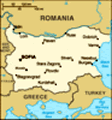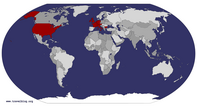Advertisement
Geo: 42.7252, 25.4815
It already seems like Varna was days ago; I can't even properly picture it in my head. It's funny how being on the coach will do that.
Our first stop of the day was the Madara Horseman, situated in a national park. We hiked up a little ways to an open area that was once a cave and is, therefore, called the Big Cave. The cliff face looms over the area, so much so that it was hard to bend backward to take a photo. It makes for amazing acoustics, demonstrated by Stefan's clapping, which echoed beautifully. He asked us to be quiet for a moment, and we heard birdsong and trickling water. Due to the presence of water, humans have been there since the 13th century BC.
The original cave was used as a temple by various religions as ruling races came and went and at one point, again because of the water, was dedicated to nymphs. Stefan made us learn a Bulgarian circle dance in the clearing (there was no one else there to witness our embarrassment), and we were awful! But apparently we're going to have to do this for other people tomorrow night. Oy!
One of the caves
in the park was fashioned into a small chapel: Christian in medieval times and it looks like Orthodox now. There were icons everywhere, and a family was lighting candles.
On we went to find the horseman a little farther up the path. And he's much smaller than I expected. It's an 8th-century, bas-relief carving into the side of the cliff around seven feet high and eight feet wide. It wasn't discovered till sometime in the 19th century, and even now you can't see it till you're right below it. It's also the oldest bas relief in Bulgaria and a UNESCO World Heritage site.
There is a lion — symbolizing the Byzantine empire — beneath the horse's front hooves, and a hunting dog follows behind. There is, unfortunately, a crack that extends from near the top of the cliff right down through the horse, just missing the horseman himself by a few inches. The crack started small but attempts at preservation have widened it. And there are bacteria in the various cracks that also cause widening; Germany is supposed to be working on some way to kill the bacteria without ruining the bas relief.
I'm not sure how we came to this, but Stefan

 Madara Horseman
Madara Horseman
It's hard to see, so look at the photo of the sign.told us that there are some archaeologists (or maybe it was anthropologists) who believe that the Great Wall of China was built to repel Bulgarian tribes back when they were nomadic. There were three tribes, and they moved in hundreds and thousands. I can see how China may have been slightly alarmed. The Bulgarians may have originally migrated from Persia, but recent tests show that DNA-wise, they have the most in common with Italians. I guess we're all related somehow.
After the horseman and a steep, rocky set of nearly 200 steps going back down, we set off for Arbanasi. Part of the main highway was closed, so we had to detour onto a very rural road that was bumpy and potholed and just broken. The villages we drove through were a bit broken too, and it's mainly elderly residents who remain in them. The young all go to the big cities of Sofia or Varna, or go live abroad even. This detour took 20 minutes; boy, was I grateful to be back on the highway! Also, I saw two dead foxes, a dead mole or possum, and something that looked like a dead hare.
We finally made it to Arbanasi,

 The Madara Horseman
The Madara Horseman
What it's supposed to look like.a smallish town dating from the 15th century. We were given 50 minutes to get some lunch on our own and I ended up with Rosemary, Marcella, and Mark eating outside. I wanted pizza, but the waiter said it would take 45 minutes. So I quickly scanned the menu again and decided on chicken salad. It took a long time coming out but it wasn't too bad. Would've been better spread between two slices of bread, but very fresh and filling. We were supposed to be back with the group by 2:50 but we were still paying our bills at that point. Fortunately, we weren't even close to being the last ones back.
Arbanasi was once one of the richest villages in all the Bulgarian lands. Most of the inhabitants were merchants or aristocrats, and they built their houses like forts. And there are ten churches.
We went to one of the churches — not much to look at from the outside, but the inside was covered in frescos. This was the Church of the Nativity and has a rare fresco of Jesus Christ Immanuel, which shows Jesus as a younger man. Usually, he's older and bearded, but in this fresco
he's pretty much just a teenager. There's a 17th-century extension on the church painted with frescos of mainly female saints to celebrate the Virgin Mary, and it's called the Female Hall (men would have services in the first chapel). It also has a Tree of Jesse fresco painted on one wall that extends up into the vault. It's one of only two in Bulgaria. The frescos also include images of Greek philosophers because at that time the Church was exploring the central idea of the universe: man; and the philosophers, I guess, provided a lot of thoughtful talking points.
There's a further addition from the 19th century and has mostly frescos of martyrs. Kind of depressing! It also has a Circle of Life fresco showing the sun in the center, then in concentric circles around the sun are the four seasons, the zodiac, and the months, all inside something that looks like a ship's wheel. Surrounding all of that is the life cycle of humans: the young climb the handles of the wheel and try to make it go faster, then they reach their pinnacle when they feel invincible (picture of a king above this); but soon age sends them down
the other side of the wheel, while they try their best to pull back on the handles in the hope of turning back time. Eventually, the wheel deposits them into Hell. And the moral is: life is hell. No, wait: it's that if you don't live a good and religious life, you will end up in Hell. That's what I meant to say.
We went to the Konstantsalieva House, one of the fortress-like houses that's now a museum. It was built in the late 17th century for the wealthy Mr. Konstantsalieva, and he must have been very wealthy indeed. The whole is surrounded by a stone wall that's probably seven feet high. The house has heavy shutters on all the windows, as well as an iron cage sticking out from one; it makes it easier for someone inside the house to peek out and see who or what is on the ground and still have some protection. As it was built during a time when Bulgaria was under the rule of the Ottoman Empire, it was a good thing to appear to be Ottoman. So in this case, the Christian owner had Ottoman-style arches built into the windows and doorways.
Inside,
there are at least two rooms for entertaining guests, a large kitchen, a ladies' room, two furnaces, and a mother-and-baby room. Not only that, it has
two indoor bathrooms — i.e., two small rooms with triangular holes in the floor that look down into the yard.
Back onto the bus and an hour later we arrived in Veliko Tarnovo. The bus couldn't take us to our hotel so parked in the lot of a different hotel to drop us off. Omigod, this hotel: big, featureless, characterless, Soviet-style building that looked practically deserted. Stefan said he was going to tell us that it was our hotel for the next two nights, just so he could see our reactions. Our actual hotel is much, much nicer.
It's the Hotel Gurko, situated on the side of a hill. Across the street (and a steep drop down) is a river, and on the other side of the river is an island with an enormous monument that was put up in the 1980s to commemorate the 800th anniversary of the founding of the Second Bulgarian Republic. It's quite the sight. It's also the view from my balcony.
My room is big. There's a table with tea things 
 My Bulgarian buddy
My Bulgarian buddy
This little guy visited my balcony and then accompanied us to dinner.and a chair, the double bed, two nightstands, a wing chair, a cabinet holding the minibar and with a TV on top, an armoire, and a vanity table with a stool. The bathroom is big too. I have to use the key to lock myself in the room as there's no deadbolt knob. A cat showed up on my deck and hung around for a while, then disappeared through the grape vine that's wound itself along the front of the building. The deck is nice, but right now there's a cricket out there that's been chirping — loudly — for the better part of 90 minutes. I'm ready to murder the little bugger but (a) I'm not going out there in the dark, and (b) unless it's wearing a top hat and carrying an umbrella, I don't really know what a cricket looks like. (Oh, God! I just Googled crickets. Gaah!)
Dinner was in the hotel restaurant. Chicken soup to start, followed by a salad of shredded carrot, with a little bit of apple and crushed walnuts. There was another flavor we couldn't identify at first, but then realized it was honey. Dessert was a little scoop of chocolate ice cream
and a cake called kadaif. It was plain-tasting, which would have been fine, but it had the strangest texture. In fact, we all at first thought it was a coconut cake, but there wasn't a shred of coconut in it. Anyway, I didn't finish mine because I just couldn't get past the strange, stringy texture.
I'm sitting up in bed now, listening to music coming from somewhere, as well as that freakin' cricket. Do crickets chirp all night long? I hope not!
Advertisement
Tot: 0.065s; Tpl: 0.012s; cc: 7; qc: 24; dbt: 0.0356s; 1; m:domysql w:travelblog (10.17.0.13); sld: 1;
; mem: 1.1mb









Aunt Marianne
non-member comment
Again thanks for sharing. Any issues with the immigrant problem over there?